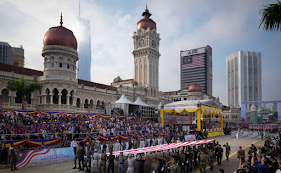If you don’t know it yet, I’ll let you in on a secret:
Malaysia is a nation of celebrations!
The majority of the celebrations are free and open to all so there’s no excuse not to attend them. Here is the list of festivals in Malaysia that I think is absolutely a must to experience.
During Hari Raya you’ll see mosques and houses decorated to the hilt with spectacular decorations and lit brightly at night. Families also travel back to their hometowns to celebrate with extended family members.
The typical food served includes satay or Malaysian kebabs, rendang or meat, lemang or sticky rice rolls, rose syrup, and a variety of sweets and biscuits.
2)
Often referred to as the Mardi Gras of Malaysia’s celebrations, Thaipusam is a colorful festival celebrating Lord Murugan’s victory over Soorapadam.
Each year the festival is celebrated in two places, one is in Batu Caves in Kuala Lumpur and the other in Waterfall Temple in Penang. For Hindus living in the country, it is a day for cleansing sins and redemption.
Celebrated for three days, you can expect traditional dance performances, singing folk songs, rhythmic drumbeats, and a procession with Lord Murugan carried on a chariot.
3) The second largest racial community in the country is Chinese, hence the Chinese New Year is also a significant celebration in Malaysia and stretches for 15 days. It typically begins with a family reunion dinner on the eve of New Year and ends with the spring lantern festival, also called Chap Goh Mei.
During the Chinese New Year, people visit temples to ask for blessings from the God of Prosperity, hand out ang pao or small red packets with money to children, give away mandarin oranges, and toss yee sang.
Make sure to attend the open houses so you can watch the impressive lion and dragon dance performances.
4) Also known as the ‘Festival of Lights’, Deepavali is another colorful festival celebrated by Hindus. It signifies the victory of light over darkness. People use colored chalks to draw a variety of shapes and patterns on the ground and scatter colored rice at the same time.
5) Mainly a thanksgiving ceremony and a celebration for a good harvest, Sabah Festival is also called Pesta Kaamatan. The month-long festival and is seen as one of the country’s biggest celebrations and has deep cultural roots.
Expect agricultural shows, cultural programs, exhibitions, buffalo races, and traditional games. There’s free-flowing rice wine for everyone to share in the midst of the carnival-like atmosphere and you’ll also see Sabah natives wearing traditional clothes.
6) Malaysia declared its independence from the British on the 31st of August 1957. Independence Day, or Merdeka Day as it is known locally, marks the creation of the Federation of Malaya after gaining independence.
In conclusion, Malaysia has everything. The country is an incredible melting pot of cultures too and offers some of the most interesting and exhilarating festivals.














Comments
Post a Comment